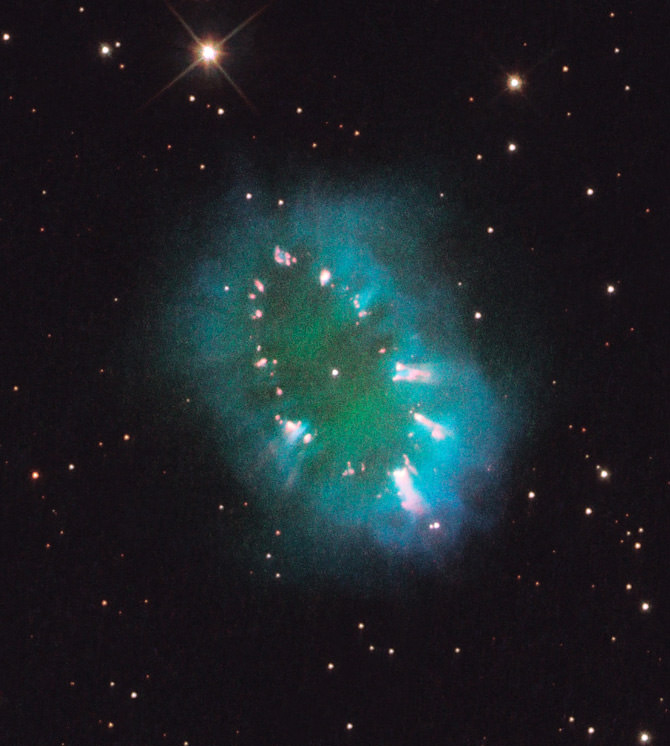[/caption]
Awww, how nice of the Hubble Space Telescope, providing us all with a little cosmic bling in this great new view of the Necklace Nebula! From the image, it’s quite obvious why this object carries the name it does (and who wants to call it by its technical name PN G054.2-03.4, anyway?). The Necklace Nebula is a recently discovered planetary nebula, the glowing remains of an ordinary, Sun-like star. You’d need to have a fairly large neck to wear this necklace, as the nebula consists of a bright ring measuring 12 trillion miles wide, dotted with dense, bright knots of gas that resemble diamonds in a necklace.
How did this unique nebula originate? A long time ago, (about 10,000 years) in an aging binary star system far away (15,000 light-years from Earth) one of the old stars ballooned to the point where it engulfed its companion star. The smaller star continued orbiting inside its larger companion, increasing the giant’s rotation rate.
The bloated companion star spun so fast that a large part of its gaseous envelope expanded into space. Due to centrifugal force, most of the gas escaped along the star’s equator, producing a ring. The embedded bright knots are dense gas clumps in the ring.
The pair is so close, only a few million miles apart, they appear as one bright dot in the center. The stars are furiously whirling around each other, completing an orbit in a little more than a day.
The Necklace Nebula is located in the constellation Sagitta. In this composite image, taken on July 2, Hubble’s Wide Field Camera 3 captured the glow of hydrogen (blue), oxygen (green), and nitrogen (red).
Thanks Hubble for the new cosmic jewelry!
Want a larger version of this bling? See the HubbleSite for more info.


That does not sound like a long time stable orbit, so these stars, they are going to collide when?
Mary
And another good question would be why the companion didn’t go supernova.
According to the paper I’ve linked above, the mass of the hot post-AGB primary star is 0.5-1.0 solar masses while the secondary is estimated to be no more than 1 solar mass. Thus neither star was massive enough to go SN to begin with (and any earlier mass transfer was apparently insufficient to bring this about either).
On another point, the secondary star is also not thought to fill it’s Roche lobe and no mass transfer to the hot post-AGB primary is seen at this time[pg. 10].
Unfortunately this cropped image does not show off the full beauty (or extent) of this small planetary. A wider-field, annotated HST image shows two reddish patches of [NII] emission near the picture edges at 2 and 7 o’clock. You can check it out here: http://imgsrc.hubblesite.org/hu/db/images/hs-2011-24-c-print.jpg
Examples of “ansae’ such as these are not uncommon in some subtypes of planetary nebulae.
I saw another picture which has been taken through the Isaac Newton Telescope, it shows something like dust lanes connecting the patches on either side that you mentioned.
Here it is: http://en.wikipedia.org/wiki/File:IP6.jpg
Beautiful image LAP, thanks for the link.
A paper on this unusual planetary nebula notes that there are both polar and equatorial outflows from the central binary pair. The secondary star, orbiting at 4-6 solar radii from the central star every 1.16 days is strongly irradiated on it’s illuminated side, and this light dominates the observed spectrum. Details and more images can be found here: http://arxiv.org/PS_cache/arxiv/pdf/1009/1009.1043v1.pdf
“and who wants to call it by its technical name PN G054.2-03.4, anyway?”
The discovery paper gives “the Necklace” the technical name IPHASXJ194359.5+170901 (it was discovered in the IPHAS survey). The PN G154.2-3.4 monniker is the IAU standardized name that includes it’s galactic coordinates. But I’m with Nancy on this one, Necklace Nebula it is!
Now it makes sense why it’s a binary. There was an article about it here.
Thanks for the links to additional pics!